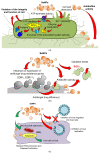A Review of the Antibacterial, Fungicidal and Antiviral Properties of Selenium Nanoparticles
- PMID: 37570068
- PMCID: PMC10420033
- DOI: 10.3390/ma16155363
A Review of the Antibacterial, Fungicidal and Antiviral Properties of Selenium Nanoparticles
Abstract
The resistance of microorganisms to antimicrobial drugs is an important problem worldwide. To solve this problem, active searches for antimicrobial components, approaches and therapies are being carried out. Selenium nanoparticles have high potential for antimicrobial activity. The relevance of their application is indisputable, which can be noted due to the significant increase in publications on the topic over the past decade. This review of research publications aims to provide the reader with up-to-date information on the antimicrobial properties of selenium nanoparticles, including susceptible microorganisms, the mechanisms of action of nanoparticles on bacteria and the effect of nanoparticle properties on their antimicrobial activity. This review describes the most complete information on the antiviral, antibacterial and antifungal effects of selenium nanoparticles.
Keywords: SeNPs; antibiotic resistance; antimicrobial activity; cytotoxicity to eukaryotic cells; mechanisms of antibacterial action.
Conflict of interest statement
The authors declare no conflict of interest.
Figures









Similar articles
-
Green and ecofriendly biosynthesis of selenium nanoparticles using Urtica dioica (stinging nettle) leaf extract: Antimicrobial and anticancer activity.Biotechnol J. 2022 Feb;17(2):e2100432. doi: 10.1002/biot.202100432. Epub 2021 Nov 21. Biotechnol J. 2022. PMID: 34747563
-
Investigation of functional selenium nanoparticles as potent antimicrobial agents against superbugs.Acta Biomater. 2016 Jan;30:397-407. doi: 10.1016/j.actbio.2015.10.041. Epub 2015 Oct 27. Acta Biomater. 2016. PMID: 26518106
-
Exploring Antibacterial Activity and Bacterial-Mediated Allotropic Transition of Differentially Coated Selenium Nanoparticles.ACS Appl Mater Interfaces. 2023 Jun 28;15(25):29958-29970. doi: 10.1021/acsami.3c05100. Epub 2023 Jun 9. ACS Appl Mater Interfaces. 2023. PMID: 37294110 Free PMC article.
-
Ag2O Nanoparticles as a Candidate for Antimicrobial Compounds of the New Generation.Pharmaceuticals (Basel). 2022 Aug 5;15(8):968. doi: 10.3390/ph15080968. Pharmaceuticals (Basel). 2022. PMID: 36015116 Free PMC article. Review.
-
Biogenesis of Selenium Nanoparticles Using Green Chemistry.Top Curr Chem (Cham). 2017 Nov 9;375(6):88. doi: 10.1007/s41061-017-0176-x. Top Curr Chem (Cham). 2017. PMID: 29124492 Review.
Cited by
-
Herbal Polyphenols as Selenium Reducers in the Green Synthesis of Selenium Nanoparticles: Antibacterial and Antioxidant Capabilities of the Obtained SeNPs.Molecules. 2024 Apr 9;29(8):1686. doi: 10.3390/molecules29081686. Molecules. 2024. PMID: 38675506 Free PMC article.
-
Optimization of Green Synthesis Formulation of Selenium Nanoparticles (SeNPs) Using Peach Tree Leaf Extract and Investigating its Properties and Stability.Iran J Biotechnol. 2024 Jul 1;22(3):e3786. doi: 10.30498/ijb.2024.413943.3786. eCollection 2024 Jul. Iran J Biotechnol. 2024. PMID: 39737201 Free PMC article.
-
Pristine Photopolymerizable Gelatin Hydrogels: A Low-Cost and Easily Modifiable Platform for Biomedical Applications.Antioxidants (Basel). 2024 Oct 15;13(10):1238. doi: 10.3390/antiox13101238. Antioxidants (Basel). 2024. PMID: 39456491 Free PMC article.
-
Plant-Based Films and Hydrogels for Wound Healing.Microorganisms. 2024 Feb 21;12(3):438. doi: 10.3390/microorganisms12030438. Microorganisms. 2024. PMID: 38543489 Free PMC article. Review.
-
Effect of Different Selenium Species on Indole-3-Acetic Acid Activity of Selenium Nanoparticles Producing Strain Bacillus altitudinis LH18.Molecules. 2024 May 23;29(11):2463. doi: 10.3390/molecules29112463. Molecules. 2024. PMID: 38893338 Free PMC article.
References
-
- Rozgonyi F., Valenta B., Brátovics A., Csire B. The sensitivity of “polyresistant” microorganisms to new antibiotics. Changes in the resistance to antibiotics of the more important pathogenic bacteria isolated from clinical specimens during 1962–1965. Orvosi Hetil. 1967;108:337–342. - PubMed
-
- Kozlov A.V., Gusyakova O.A., Lyamin A.V., Kezko J.L., Khaliulin A.V., Ereshchenko A.A. Polyresistent microflora in the structure of microorganisms divided from blood of patients of the general hospital. Klin. Lab. Diagn. 2018;63:574–578. - PubMed
Publication types
Grants and funding
LinkOut - more resources
Full Text Sources
Molecular Biology Databases
Miscellaneous

